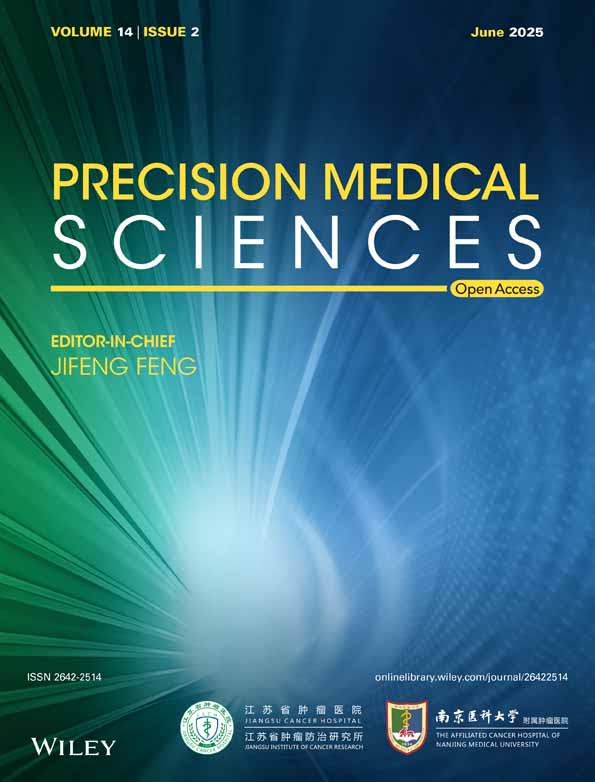Visualization and hotspot analysis of CAR-T research based on CiteSpace
Kejin Li and Yue Teng contributed equally to this work.
Abstract
Through bibliometric analysis of CAR-T research hotspots and development trends, a reference is provided to promote cutting-edge research on CAR-T. Acquired research literature on CAR-T cells from the Web of Science Core Collection (WOSCC) as of November 20, 2023, and utilized CiteSpace software to conduct bibliometric and knowledge graph analysis. A total of 3664 articles of valid literature were obtained between 1996 and 2023. The number of publications grew slowly from 1996 to 2014 and increased sharply from 2015. In particular, from 2018 to 2022, the number of publications showed explosive growth and remained at a high level. The authors of the papers are relatively scattered, and there is little cooperation between authors. The United States has published the most papers in this field and has close cooperation with global research institutions, while China ranks second in terms of the number of papers published and has less academic cooperation or exchanges with other countries/regions. The main research hotspots include chimeric antigen receptor, immunotherapy, cytokine release syndrome, etc., which belong to two categories: the treatment mechanism and application of CAR-T and adverse reactions and safety management. Keyword mutation analysis predicts that future research hotspots will mainly be related to technical research, safety, and post-treatment management of CAR-T. CAR-T is a hot research field and is still in a rapid development stage. Domestic researchers need to strengthen exchanges and cooperation with international researchers. CAR-T-related technical research, safety, and post-treatment management may be the hot spots of future research.
1 INTRODUCTION
Chimeric antigen receptor T-cell immunotherapy (CAR-T) is a method of modifying human T cells in vitro through genetic engineering to give them a stronger ability to recognize and attack tumor cells, and then infusing them back into the patient's body for the treatment of the disease. As a revolutionary cell immunotherapy, CAR-T has developed rapidly in recent years and has achieved relatively satisfactory results in laboratory research and treatment of malignant tumors, especially hematological malignancies.1 As an anti-tumor therapy, the goal of CAR-T therapy is clinical transformation and clinical application.2 Many scholars have studied this therapy from multiple aspects, including the therapeutic efficacy,3 safety,4 treatment optimization,5 target selection,6 relationship with TME,7 and application in solid tumors8 and hematological malignancies.9 Bibliometrics is a multidisciplinary field that studies literature and other knowledge carriers quantitatively via the use of mathematical and statistical methodologies.10 Through an extensive study of relevant literature, valuable insights can be obtained on specific subjects. CiteSpace is an information visualization software used to analyze literature, which can help you understand the research hotspots and frontiers in a certain discipline.11 In order to fully understand the development status of CAR-T, this study retrieved and summarized the relevant literature on CAR-T, expounded the research status and hot areas of CAR-T, and further analyzed future research hotspots to provide reference for promoting the frontier research of CAR-T. The specific report is as follows.
2 DATA CURATION AND METHODS
2.1 Data collection
The study data was retrieved from the web of science database on November 20, 2023, with search title of “Chinese antigen receptor T cell” the time was set up to the search date, and article type set to academic with language setting limited to English. At the same time, ensuring the comprehensiveness of the research content, filtering out invalid literature, and ultimately obtaining the number of valid literatures.
2.2 Data analysis
Microsoft Office Excel 2021 was used for managing data, while CiteSpace was utilized to analyze it and graphically map scientific knowledge. CiteSpace is a powerful visual analysis tool specially used to explore the relationships and development trends among scientific documents.12 Different from traditional literature retrieval tools, CiteSpace can dig out deep correlations and trends from massive documents through data mining and information visualization technology, providing strong support for research.13 Therefore, this study mainly analyzes the effective literature obtained from the Web of Science through this software, and due to the relatively large number of literature, in order to optimize the research results, the initial k value is set to 10 (Figure 1; Table 1).
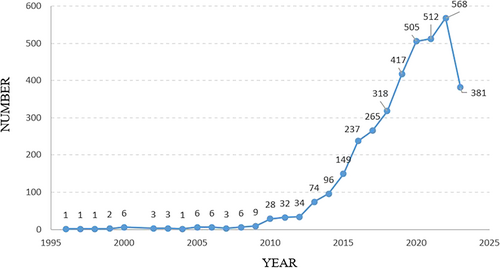
| Number | Author | Frequency | First publication time |
|---|---|---|---|
| 1 | June Carl H | 93 | 2011 |
| 2 | Grupp Stephan A | 41 | 2013 |
| 3 | Porter David L | 33 | 2011 |
| 4 | Lacey Simon F | 32 | 2014 |
| 5 | Levine Bruce L | 30 | 2012 |
| 6 | Huang He | 27 | 2019 |
| 7 | Dotti Gianpietro | 25 | 2011 |
| 8 | Perales Miguel-Angel | 24 | 2021 |
| 9 | Kenderian Saad S | 22 | 2020 |
| 10 | Hu Yongxian | 22 | 2020 |
3 RESULTS
3.1 Analysis of publication trend
As can be seen from Figure 1. A total of 3664 valid CAR-related papers were obtained, and the literature on CAR-T cells has undergone various phases of development between 1996 and 2023. There were hardly any relevant materials published between 1996 and 2004, no more than 10 articles per year. There was a slow but steady rise in research from 2005 to 2014, with just a few dozen publications published per year. The amount of relevant literature has grown significantly since 2015, particularly between 2018 and 2022, when there was an annual large exponential increase in the number of research literature. By 2023, although the number of relevant documents has declined, it still remains at a relatively high level. These findings indicate that CAR-T, a frontier subject that has received a lot of attention, is increasing in research intensity and depth and that it may face further challenges and opportunities in the future.
3.2 Analysis of the authors
As can be seen from Table 1. The top three authors in terms of number of publications are June Carl H, Grupp Stephan A, and Porter David L, and they have published a large number of papers. From the author co-occurrence map (Figure 2), a total of 279 nodes and 885 links are formed, and the network density is relatively low, only 0.0226. The results show that there is little cooperation between authors, which to a certain extent shows that there is a significant “small world” phenomenon in this field. From a larger perspective, there is a certain cooperation network within scholars in different directions, and a variety of complex cooperation relationships have co-occurred.
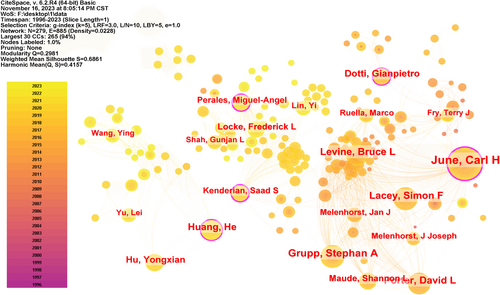
3.3 Analysis of major research countries/regions
As can be seen from Table 2 and Figure 3, the United States has significantly more publications in this field than other countries/regions, with a centrality as high as 0.69, indicating that it has extensive cooperative relations with global research institutions. China ranks second in publications but has a lower centrality, indicating that there is less academic cooperation or exchange with other countries/regions. Germany, the United Kingdom, and other European countries have more publications and higher centralities, indicating that researchers in these countries have close cooperation and a high research status in this field.
| Number | Country/Region | Frequency | Centrality |
|---|---|---|---|
| 1 | USA | 1902 | 0.69 |
| 2 | Peoples R China | 554 | 0.05 |
| 3 | Germany | 278 | 0.14 |
| 4 | England | 138 | 0.18 |
| 5 | France | 100 | 0.08 |
| 6 | Italy | 82 | 0.06 |
| 7 | Canada | 42 | 0.02 |
| 8 | Japan | 41 | 0.01 |
| 9 | Australia | 35 | 0.01 |
| 10 | Spain | 32 | 0.01 |
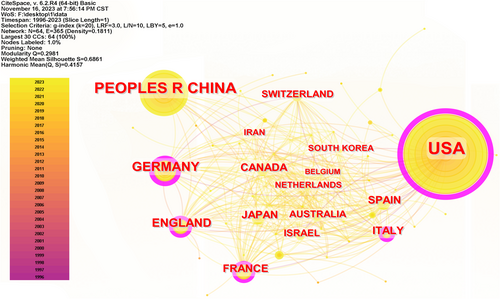
3.4 Keyword co-occurrence analysis
From the keyword co-occurrence graph (Figure 4), we can see that there are 288 nodes, 2588 links, and a network density of 0.0835, indicating that the connections between the nodes are relatively close. The larger the node of the keyword co-occurrence map, the higher the frequency of the keyword, which reveals the research hotspots in this field to a certain extent. As can be seen from Table 3, therapy, chimeric antigen receptor, immunotherapy, expression, adoptive immunotherapy, cancer, lymphocytes, and efficacy are keywords with high frequency of occurrence, indicating that the treatment mechanism and efficacy of CAR-T in tumor treatment, especially hematological malignancies, have always been the focus of research. The frequency of cytokine release syndrome and management is also high, indicating that the safety of CAR-T and post-treatment management have also attracted attention and become a research hotspot.
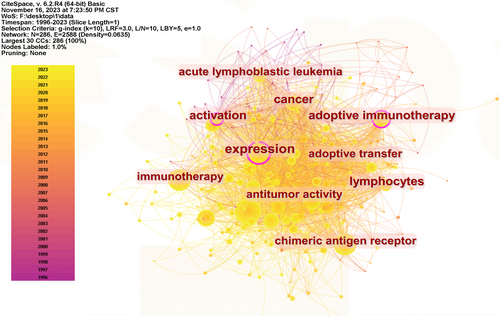
| Number | Label | Frequency | Number | Label | Frequency |
|---|---|---|---|---|---|
| 1 | Therapy | 425 | 16 | Lymphoma | 128 |
| 2 | Chimeric antigen receptor | 327 | 17 | Persistence | 121 |
| 3 | Immunotherapy | 303 | 18 | Car | 120 |
| 4 | Expression | 301 | 19 | Transplantation | 116 |
| 5 | Adoptive immunotherapy | 278 | 20 | Children | 116 |
| 6 | Cytokine release syndrome | 232 | 21 | Malignancy | 107 |
| 7 | Cancer | 194 | 22 | cd19 | 106 |
| 8 | Lymphocytes | 186 | 23 | Chemotherapy | 93 |
| 9 | B cell | 184 | 24 | Safety | 93 |
| 10 | Activation | 182 | 25 | Antitumor-activity | 87 |
| 11 | Acute lymphoblastic leukemia | 165 | 26 | Survival | 84 |
| 12 | Remissions | 158 | 27 | Multiple myeloma | 83 |
| 13 | Management | 153 | 28 | Leukemia | 82 |
| 14 | Efficacy | 142 | 29 | Outcome | 80 |
| 15 | Antitumor activity | 128 | 30 | Antibody | 78 |
3.5 Keyword cluster analysis
From the keyword clustering graph (Figure 5), we can see that there are six clustering labels, with a Q value of 0.2981 and an S value of 0.6861, indicating that the keyword clustering map is significantly clustered, and the clustering credibility and consistency are high. Referring to the keyword clustering table (Table 4), the clustering labels can be divided into two categories, namely ① CAR-T treatment mechanism and application: #1, #3, #4, and #5; ② CAR-T adverse reactions and safety: #0, #2. From the clustering labels, we can see that the treatment mechanism and application of CAR-T, as well as the adverse reactions and safety management of CAR-T are research hotspots.
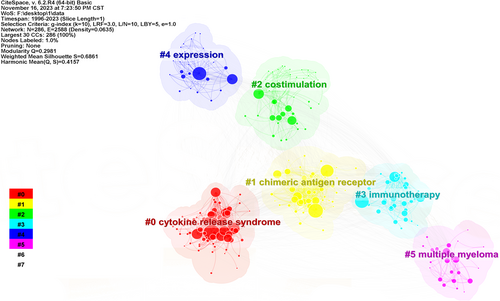
| Cluster ID | Cluster label | Silhouette | Mean (year) | Label (LLR) |
|---|---|---|---|---|
| #0 | Cytokine release syndrome | 0.919 | 2017 | Cytokine release syndrome, children, remission, acute lymphoblastic leukemia |
| #1 | Chimeric antigen receptor | 0.893 | 2014 | Chimeric antigen receptor, adoptive cell therapy, therapy, immune-related adverse events |
| #2 | Costimulation | 0.965 | 2011 | Costimulation, antitumor activity, adverse event, in vivo persistence |
| #3 | Immunotherapy | 0.795 | 2007 | Immunotherapy, cancer, t cell, lentiviral vector |
| #4 | Expression | 0.950 | 2005 | Expression, solid tumors, lymphocytes, acute myeloid leukemia |
| #5 | Multiple myeloma | 0.852 | 2018 | Multiple myeloma, cellular therapy, ct, hematopoietic stem cell transplantation |
3.6 Keyword mutation analysis
After keyword mutation analysis, 24 emergent words were obtained. As shown in Figure 6, from 2000 to 2016, the research focused on the treatment mechanism and application research of CAR-T, mainly including hot topics such as adoptive cell therapy and gene therapy; from 2019 to 2020, the research focused on the application research of CAR-T in childhood lymphocytic leukemia; from 2020 to 2023, the research hotspots mainly included chimeric antigen receptor, neurotoxicity, management, etc., indicating that the current hot research direction is the related technical research of CAR-T. At the same time, the safety of CAR-T and post-treatment management are the focus of attention.
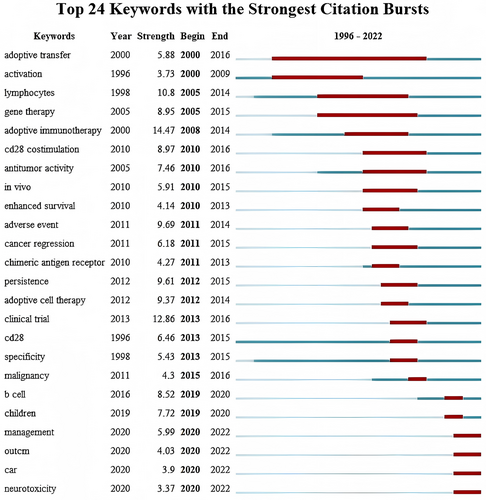
4 DISCUSSION
4.1 The number of CAR-T papers has gradually increased and maintained a high level of development
This study shows that the number of literatures related to CAR-T shows an overall upward trend every year, and according to different growth rates, we can divide it into a stable period from 1996 to 2004, a slow growth period from 2005 to 2014, a rapid growth period from 2015 to 2022, and a high-level stable period in 2023. The three typical CAR-T incidents that occurred between 2012 and 2014 may have contributed to a notable rise in 2015. The first event was in 2012, when a 7-year-old child with acute lymphoblastic leukemia became the world's first child to receive CAR-T treatment, resulting in complete relief of symptoms.15, 14 The second event was that in 2013, “Science” named the top 10 breakthroughs in science for the year, with “cancer immunotherapy” ranking in first place. The third incident occurred in 2014, when 90% of the 30 patients with acute lymphoblastic leukemia who underwent CAR-T therapy fully recovered from their symptoms.16 It can be determined that after three typical occurrences during these 3 years, researchers in associated fields were interested in CAR-T, which resulted in the fast growth of related research beginning in 2015. Even if there is less relevant literature by 2023, it is still at a comparatively high level. Overall, it is evident that CAR-T cell therapy is a cutting-edge field that has drawn a lot of interest, that its depth and excitement for research are growing, and that it may face further challenges and opportunities in the future.
4.2 CAR-T researchers need to strengthen cooperation
There is little cooperation between authors of CAR-T papers. CAR-T is currently in a rapid development and exploration stage. The lack of communication and cooperation between researchers will largely lead to duplication of research content and affect academic efficiency. Therefore, researchers need to strengthen horizontal cooperation, conduct joint research, and jointly promote the depth of CAR-T application research. From the perspective of the country/region distribution of the number of papers published, the United States has the largest number of papers published and has close cooperation with global research institutions, further proving that the United States is the most influential country in CAR-T and is far ahead of other countries in research in this field.17 China ranks second in the number of papers published. In recent years, China's research in this field has also increased significantly,18 but there is little academic cooperation or communication between domestic researchers and other countries/regions. A close international cooperation model will help promote the in-depth development of CAR-T research and provide relevant scholars with broader cooperation opportunities and academic exchange platforms, which can better promote the development of the CAR-T research field and benefit more patients. Therefore, domestic researchers need to further strengthen exchanges and cooperation with the international community.
4.3 CAR-T research hotspots and cutting-edge analysis
From the results of keyword co-occurrence and cluster analysis, the therapeutic mechanism and application of CAR-T, as well as adverse reactions and safety management, are the research hotspots of CAR-T. From the perspective of the therapeutic mechanism and application of CAR-T, CAR-T is an adoptive immune cell therapy technology that has developed rapidly in recent years. Its targeting, killing activity, and persistence are superior to those of conventionally applied immune cells. It is a new targeted therapy for tumor immune cell therapy and has achieved remarkable results in the treatment of malignant tumors, especially hematological malignancies.17, 18 In addition to tumors, CAR-T cell therapy also has great research potential in the treatment of autoimmune diseases, cardiac fibrosis, and chronic hepatitis B or C virus infection.19, 20 With the continuous emergence and development of new technologies, the development and application of CAR-T related technologies remain a research hotspot. From the perspective of adverse reactions and safety management, CAR-T has made major breakthroughs in the treatment of hematological malignancies, but it still faces many challenges and difficulties, such as toxic side effects, off-target effects, and disease recurrence. As a new treatment method in the exploratory stage, CAR-T has always focused on its safety in the laboratory and clinical application stages and has accumulated rich experience in intervening in adverse reactions such as cytokine release syndrome and nervous system toxicity. However, it has not yet achieved ideal results in terms of adverse reaction control and mechanism. Adverse reaction and safety management have always been a hot topic in this research field.
In the keyword mutation graph, the research hotspots from 2020 to 2023 mainly include chimeric antigen receptor, neurotoxicity, management, etc., indicating that CAR-T related technical research, safety, and post-treatment management may be the hot spots of future research, especially post-treatment management, which has not been involved in previous studies. In order to obtain more significant CAR-T application effects, many CAR-T application technical issues such as screening suitable patients, improving target specificity, and promoting cell migration to tissues need further exploration. CAR-T is currently ineffective in the treatment of solid tumors but has shown great potential in the treatment of autoimmune diseases, viral infections, etc. These will make CAR-T related technical research a hot spot in the future. As the adverse reactions such as neurotoxicity and off-target effects currently restrict the application effect of CAR-T, strengthening safety management and controlling and reducing the occurrence of adverse reactions will be a hot spot for future research as new progress is made in treatment.
The current research status analysis on CAR-T is mainly reflected in the literature review of the treatment mechanism and application of CAR-T in tumors and other diseases. There is still a lack of in-depth visualization analysis of data. This study can discover the rules, hotspots, and trends of current CAR-T research through in-depth and comprehensive data analysis and present the data intuitively in the form of graphics, charts, etc., to help researchers and related readers identify the current research status, hotspots, and development trends of CAR-T and provide reference for better promoting CAR-T application research.
5 CONCLUSION
In the past few decades, the number of research papers on CAR-T has shown a gradual upward trend, and this trend is expected to continue for some time to come. Researchers from all countries need to strengthen cooperation; especially domestic researchers need to strengthen international exchanges and cooperation. CAR-T-related technical research, safety, and post-treatment management may be hot topics for future research. This study analyzes the hot topics of research papers published at home and abroad, hoping to provide valuable references for further research in this field. In future research, the latest research literature should be continuously included to further validate the research hotspots and evolutionary trend analysis results of this study, providing reference for the development trend of CAR-T research.
AUTHOR CONTRIBUTIONS
Kejin Li: Co-first author; contributed to literature retrieval, manuscript drafting, and partial content organization. Yue Teng: Co-first author; participated in literature screening, data analysis, and figure/table preparation. Jianqiu Wu: Corresponding author; supervised the research direction, critically revised the manuscript, and handled correspondence with the editorial office. Wenjuan Li: Corresponding author; involved in study design, data analysis, and manuscript structure refinement. Liuliu Zhang: Assisted in literature screening, data curation, provided key insights for the discussion, and participated in proofreading. Xiaoxu Zhi: Contributed to figure preparation, data organization, provided input on the background section, and assisted in proofreading.
ACKNOWLEDGMENTS
This study was supported by the Beijing Xisike Clinical Oncology Research Foundation (Y-NCJH202201-0013); Beijing Health Promotion Association, BJHPA (Z2023005019073); and Science and Technology Development Fund project of Jiangsu Cancer Hospital (ZH202201).
CONFLICT OF INTEREST STATEMENT
The authors declare no conflicts of interest.



